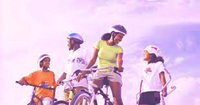Knee Pain, Knee Injuries and Iliotibial Band Syndrome
Knee pain and knee injuries, because of Iliotibial Band Syndrome, maybe extraordinarily painful and irritating damage that puts massive stress on both the knee and hip joints.
Knee aches and knee accidents are very commonplace amongst runners and cyclists. However, they don't usually arise in an instant, like a hamstring strain or groin pull, however typically start off as a twinge or niggle, and progress fast to debilitating sports activities damage that can sideline the nice of us for weeks.
For individuals who are not acquainted with Iliotibial Band Syndrome, permit's start through having a have a look at the muscle chargeable for the hassle. The iliotibial band is absolutely a thick tendon-like part of any other muscle referred to as the tensor fasciae overdue. This belt passes outside the thigh and attaches below the knee.
If you examine the anterior (the front) view of the proper thigh muscle groups and comply with the tendon of this muscle down, you'll see that it runs all of the ways to the knee. This thick band of tendons is the iliotibial band. Or iliotibial tract, as it is categorized within the diagram.
The knee ache occurs when the tensor fasciae latae muscle and iliotibial band grow to be tight. This reasons the tendon to drag the knee joint out of alignment and rub towards the out of doors of the knee, which results in inflammation and ache.
Causes
There are important causes of knee pain associated with iliotibial band syndrome. The first is "overload" and the second one is "biomechanical mistakes."
Overload is not unusual with sports that require numerous jogging or weight-bearing hobby. This is why ITB is generally a runner's harm. When the tensor fasciae latae muscle and iliotibial band become fatigued and overloaded, they lose their ability to effectively stabilize the whole leg. This in flip locations stresses the knee joint, which leads to ache and harm to the systems that make up the knee joint.
Overloading on the ITB can be a result of quite a number of factors. They consist of:
Exercising on tough surfaces, like concrete;
Exercising on the choppy ground;
Beginning an exercise application after an extended lay-off duration;
Increasing exercise depth or period too speedy;
Exercising in wiped out or sick-becoming footwear; and
Excessive uphill or downhill walking.
Biomechanical mistakes encompass:
Leg duration variations;
Tight, stiff muscle mass inside the leg;
Muscle imbalances;
Foot shape issues together with flat feet; and
Gait, or jogging fashion issues together with pronation.
Treatment For Iliotibial Band Syndrome
Firstly, make certain to put off the motive of the problem. Whether or not it's an overload problem or a biomechanical problem, ensure steps are taken to put off the motive.
The fundamental treatment for knee pain that is affected by ITB Syndrome is not extraordinary to most other soft tissue accidents. Immediately following the onset of any knee ache, the R.I.C.E.R. Regime must be implemented. This involves Rest, Ice, Compression, Elevation, and Referral to the ideal expert for an accurate analysis. It is essential that the R.I.C.E.R. Regime be implemented for as a minimum the primary 48 to 72 hours. Doing this will come up with the first-class viable hazard of a whole and full healing.
Article with the aid of Brad Walker. Brad is the world over diagnosed stretching and sports activities harm representative with 20 years of sensible enjoy within the health and health industry. Brad is a Health Science graduate of the University of New England and has postgraduate accreditations in athletics, swimming, and triathlon education. He has worked with an elite degree and world champion athletes and lectures for Sports Medicine Australia on harm prevention. Brad is likewise the author of The Stretching Handbook, The Anatomy of Stretching, and The Anatomy of Sports Injuries.









If you have any doubts,Please let me know